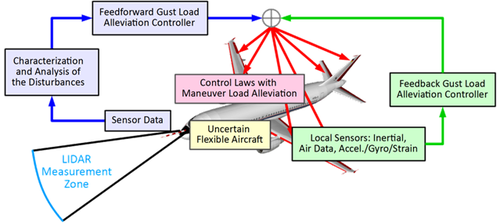
The project B2.3 "Active load Reduction for enabling a 1-G wing using forward-looking and distributed sensors" (ARGO) is researching active gust load reduction concepts for future commercial aircraft. Since gust loads are currently an important factor in structural sizing, active gust reduction can make a significant contribution to reducing fuel consumption due to a lighter structure.
This project aims at significantly reducing gust and manoeuvre loads down to a level equivalent to steady 1 to 1.5g flight, which implies that the aircraft needs to actively alleviate loads at a high level of reliability at all time and all flight conditions. In order to enable wing structural sizing to be based on the load level as close as possible to the loads experienced during 1g steady flight, with the most efficient lift distribution, various new technologies need to be developed and maturated. These technologies can be passive (e.g. aeroelastic tailoring) or active (e.g. gust and manoeuvre load alleviation functions). With a drastically reduced weight, the wing is expected to be much more flexible which raises the need of having multiple actuators along the wing. Based on the aircraft configuration, such actuators could be standard actuators such as ailerons, flaps, spoilers, but for future advanced aircraft configurations also active flow control, morphing surfaces, flexible control surfaces or distributed propulsion. When considering active load alleviation strategies, various technologies must be combined: 1) sensor systems which are able to capture relevant information for the load alleviation task, 2) actuation systems which provide the right control degrees of freedom with sufficient control authority and 3) control techniques which determine the commands required for the actuation system based on the current situation as determined by the sensor system.
The concept of operations and requirements are derived and the flight mechanics are investigated. A flight dynamics model is generated and a new physical model reduction is developed and used to generate reduced-order models that can be used for control design purposes, with physically interpretable parameters. Requirements related to sensors, sensor network and actuators are established. The concept incorporates new active control devices beyond the state-of-the-art.

The concept of operations and requirements are derived and the flight mechanics are investigated. A flight dynamics model is generated and a new physical model reduction is developed and used to generate reduced-order models that can be used for control design purposes, with physically interpretable parameters. Requirements related to sensors, sensor network and actuators are established. The concept incorporates new active control devices beyond the state-of-the-art.
A key element of the project is the assessment and benchmarking of complete load alleviation systems and architectures. To this end, the capabilities of each combination of sensors and actuators must be assessed in a fair and reproducible way. The fairness of the evaluation involves clear, objectively measurable, and stable evaluation criteria and the need for a similar level of attention/refinement on the respective design for each controller (new controller optimized for each sensor and actuator configuration). Reliability and robustness of the achieved alleviation performance (i.e. resilience in failure cases and impact of uncertainties) are key outputs of this assessment. Certificability shall be addressed w.r.t. current certification specifications and proposed amendments. The effects of uncertainties shall be assessed by propagating uncertainties through the entire system (not only the flight control system). The results are shared with ICA-B5.1 iteratively to update the configuration of the mid-range reference aircraft.
A reliable load alleviation control system for all flight conditions is strongly affected by numerous uncertainties such as flight dynamics modelling and aerodynamic parameter uncertainties. In view of these uncertainties, this project on active load alleviation will be closely accompanied by uncertainty quantification studies.
By incorporating modern probabilistic computational methods into the design process, the high requirements with regard to the systems robustness and reliability will come into reach. Stochastic surrogate models, allowing for efficient Bayesian model calibration and selection, are a key methodological tool to incorporate uncertainties. The proposed methods deliver a more precise definition of sensor and actuator requirements. In particular, the impact of sensor and measurement errors are investigated by error propagation taking into account all sensors, ambient conditions and the load alleviation system itself. System failures, such as failures of control devices of unreliable sensor information, will be covered by adaptive and robust flight control design.
The investigated uncertainty quantification methods are crucial for the engineers during the design phase, but also later on in order to be able to build a safety case for certification authorities.
Dr.-Ing. Meiko Steen
Institut für Flugführung
+49 531 391 9837
Dr. Nicolas Fezans
Institute of Flight Systems Flight Dynamics and Simulation
+49 531 295-2653
Jun.-Prof. Dr.-Ing. Ulrich Römer
Institute of Dynamics and Vibrations
+49 531 391 62120
Institute of Flight Guidance
Technische Universität Braunschweig
Hermann-Blenk-Str. 27
D-38108 Braunschweig
Institute of Flight Systems, Flight Dynamics and Simulation
German Aerospace Center (DLR)
Lilienthalplatz 7
D-38108 Braunschweig
Institute of Dynamics and Vibrations
TU Braunschweig
Schleinitzstraße 20
D-38106 Braunschweig